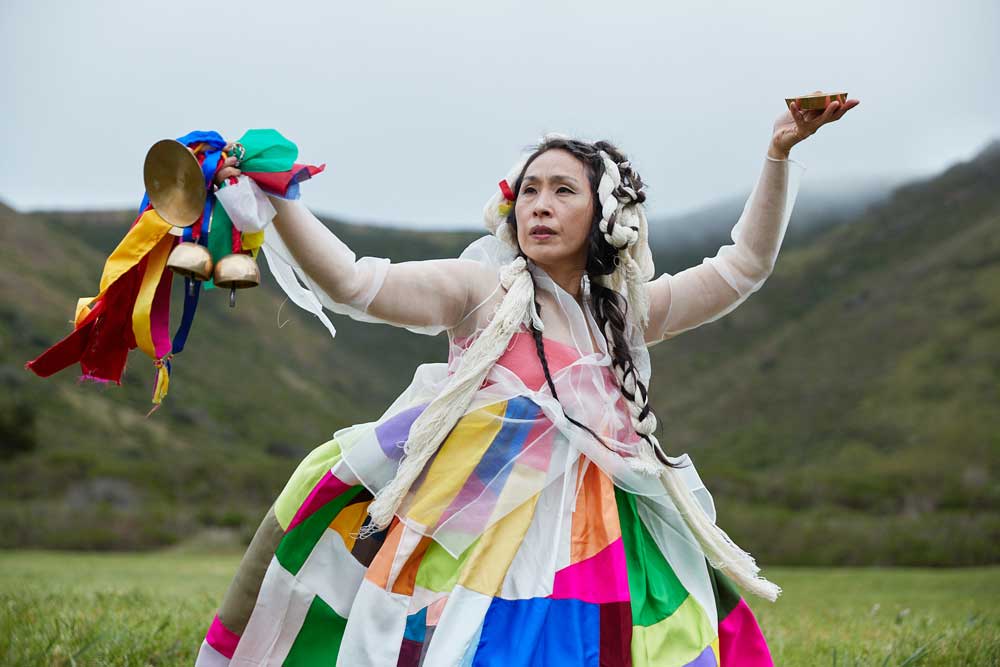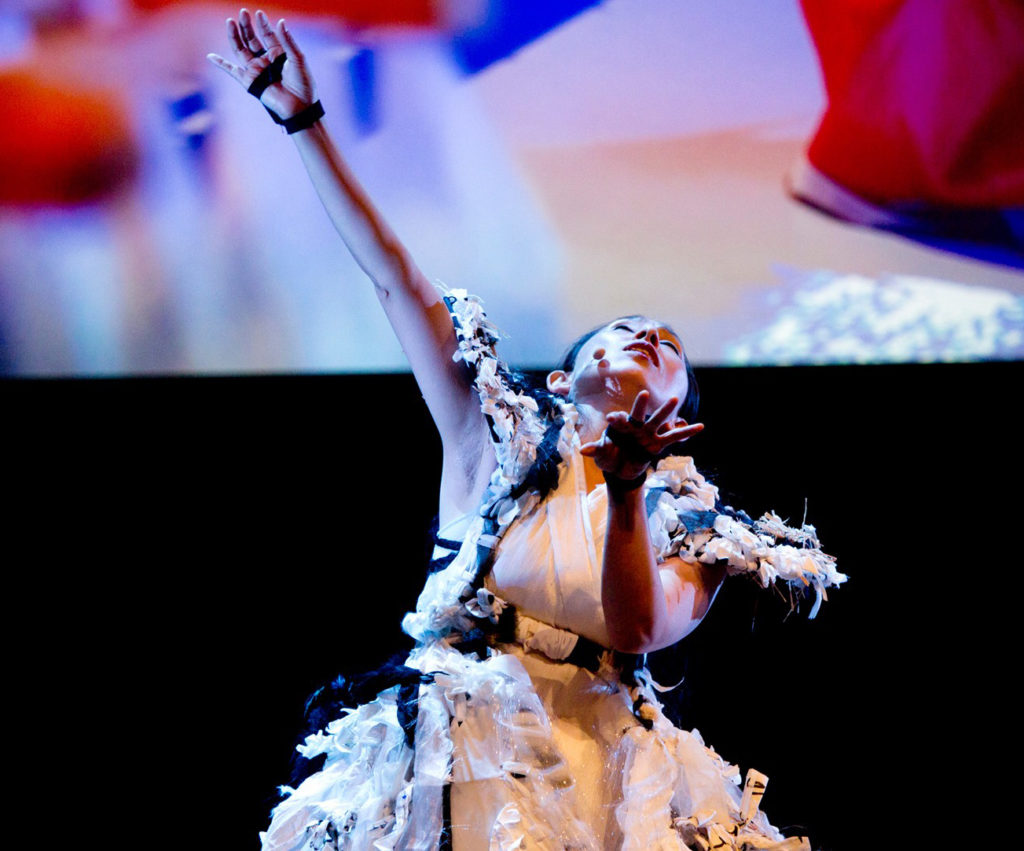Wed January 7th Open 11 AM–5 PM
In Conversation with Dohee Lee: Exploring Her Journey to Shamanism through Dance
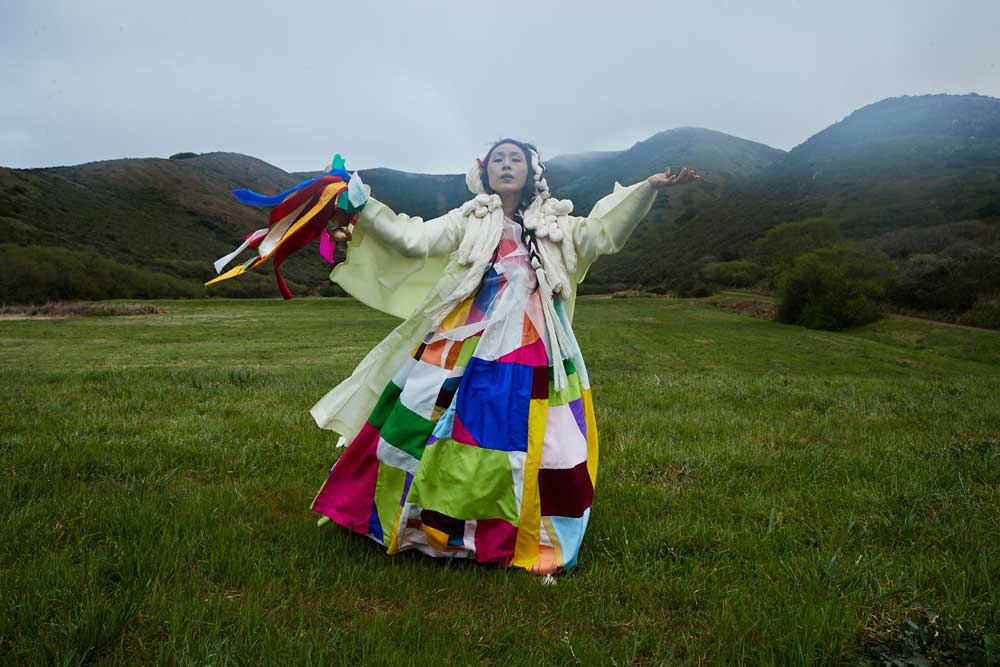
Dohee Lee. Photo by Alex Farnum for YBCA.
For almost 15 years, YBCA has worked in a deep relationship with Dohee Lee, a renowned Korean shamanistic performance and dance artist, whose work bridges the gap between ancestral traditions and more modern, avant-garde stylings. Recently, we sat down with Lee to discuss her upcoming show, MU–Connector/When the land stands alone, performing at YBCA on June 23–24, 2023.
This multi-part ritual theater experience promises to be a breathtaking and thought-provoking exploration of historical cultural practices and indigenous land preservation. Lee has crafted an immersive and captivating experience combining dance, chanting, drumming, and storytelling to produce a communal creative ritual.
With an altar installation and call for community participation, MU–Connector/When the land stands alone reflects on our shared history, myths, and ancestral land, while also exploring the wounds inflicted by systemic oppression in the U.S. and other homelands. We took time to learn more about Lee’s creative process and the inspiration behind her powerful work.
YBCA: Tell us about yourself and how you got involved in your art form. What was your initial introduction to dance as a practice and what made you want to pursue it as a full-time venture?
Dohee Lee: Dance is very important for my life because when I was young, it was a calling to me: “Dohee, you have to dance.” So since then, I felt the movement in my life and also learning Korean traditional dance. Those are very important for me to understand my culture and how those are really shaping me in different ways when dancing. When you’re doing a dance, you always hear the music and then I realized, “Oh god, I need to study music, too.”
And then when I was doing music, all this dance and music came from some roots. And that’s what I called my native practice that I studied, shamanism. So my work is deeply rooted in shamanism. Doing that practice over and over and being clear about my intention of doing this work has really guided me to become a full-time artist. All my cultural practices have been important to my work as it is connected to healing.
YBCA: Has shamanism and the ritual aspect of your work always been a part of your practice, or is it something that you incorporated later on in your journey?
Dohee Lee: Well, this shamanism, the ritual practice that I call it, is always in my work. And even how I create and what are the structures and all those, I follow that foundation, but in a way, I try to also create in different ways too. From the beginning when I create my own work, the spirituality and ritual practice is present, you know? It’s always a huge part of the work.
YBCA: As you’re incorporating it into your work, are you going through your own sort of spiritual journey? Can you talk to me a little bit about what that journey looks like for you? How do you continue to evolve in that way and how has it continued to inform your work?
Dohee Lee: Yeah, I think really it kind of comes into the question of your identity, where you are from, who I am, what do I do, and why am I doing it and how do I want to do it? All the question is really about, do I understand my life? So that’s kind of the part that supports doing this practice.
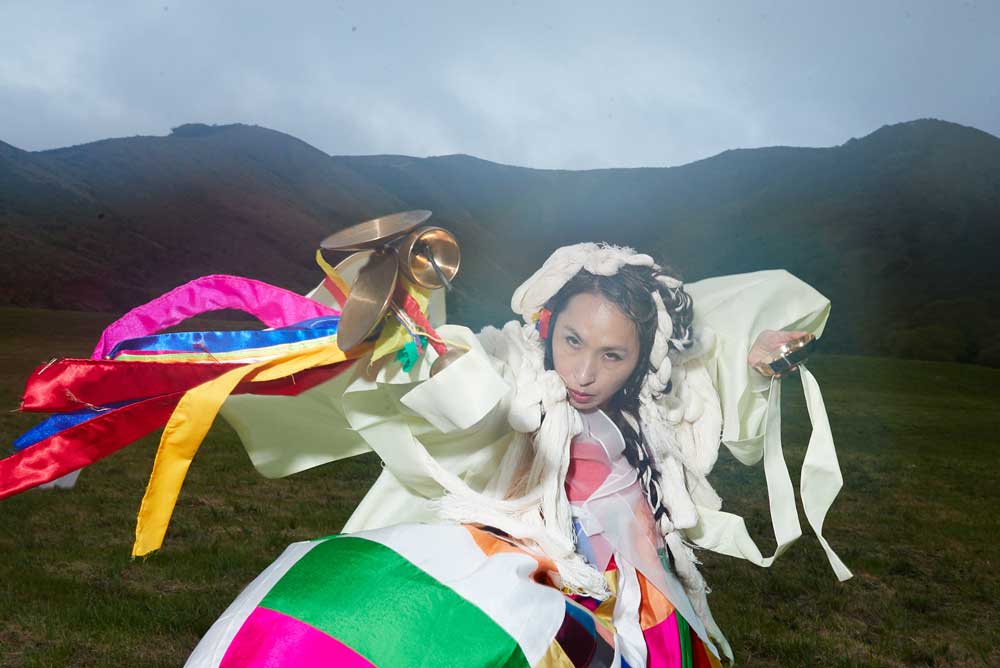
Dohee Lee. Photo by Alex Farnum for YBCA.
YBCA: Can you talk about how you got into ancestral traditions?
Dohee Lee: I trained in my art practice back in Korea. Studying traditional dance and music is deeply rooted in shamanism. When I was doing it, that was part of my spiritual journey too. Many of my friends who started that same study chose a different way, but the spirituality was strongly pulling me in, to go there, and that was learning it and doing it as part of the process of this practice. So in the beginning, I didn’t know that I was going on that path, but when I’m doing it every time, I feel like it’s a riddle and you’re figuring out, “Oh, that’s why I’m doing this. Oh, okay. I can see the puzzles are coming in one piece.”
I’m still working on it, I’m finding little pieces here and there and putting them in to really see what my path looks like. I’m still working on it, but that is kind of my spiritual journey. It is ongoing and they’re informing what to do, how to do and why this matters and why this matters to the people. So that spiritual journey really taught me about what is the meaning of community and what is the meaning of village, what is the meaning of communal spirit.
YBCA: Spiritual practice is a kind of a heavier thing to bring into your art, especially dance. What advice would you give people, dancers, or artists who are working to include ancestral wisdom and spiritual practices into their art?
Dohee Lee: If people are interested in this type of ritual work, I feel like they need to ask themselves, “Why am I into this?” And really reach out to themselves to ask those questions. So you work on your own and also research and study on your own and also find the right people. Finding the right people who can guide you doing this practice. I want to emphasize that this is not the theme or object that you can bring to it and you can use it, this is not about that practice.
You need to understand what those are. What are those meanings, what are the functions of it, then you can really start integrating those themes into your practice. So I’m really strongly encouraging people who are interested, ask yourself, why am I into this? And then finding the right people to continue in your practice.
YBCA: Can you tell us about your migration story to the Bay Area and the United States, what that transition was like for you as a person and artistically? How did that change your trajectory or how you approach your work?
Dohee Lee: My immigration story really begins as an artist. At the time, I wanted to do art that was more avant garde art, and even though I was studying traditional art, I was very curious about that different art form which is very new, experimental. So that’s why I came here, to actually do some new work. But the interesting part was when I arrived here, I went back to my roots, my culture, my practice. And from there finding the foundation, how the foundation is so rich and then I can see the possibility of how I can integrate it into new forms of art.
I think that was really beautiful, that realization. You know when I came here, I didn’t know. But then I came here and saw our people, and our people meaning Korean-Americans, Korean descendants and also Asian diaspora. When I met them, it was clear how important it is to get back to the roots and really understand the culture. And see what creative practice we can continue to do. It’s not about outside, it’s inside.
So that was really powerful and really important to really understand them.
YBCA: How do you hold the tension between being innovative and progressive and pushing things forward with your work, while also remaining connected to the cultural and traditional roots and practices? How do you balance that tension and how do you work through those things?
Dohee Lee: At the beginning, I felt that I had to choose one. Maybe that was the tension that I felt from the outside. My inside of my system was holding both, that’s who you are too. Tradition is a part of you and something new, art, is a part of you. So in the beginning, I was troubled with it, but in processing all those questions and answers myself and coming all the way here, now I see it’s a blessing. So many blessings I felt, wow, yeah, these are my roots and these are my ancestors and that’s my tradition, but also I can see this is who I am—born in this time and living in this time.
How can I say or share our stories in different ways while the structure, the foundation that I’m using is from tradition? It looks so different, but to me it’s the same. I am so grateful to be doing this practice long enough to hold both without struggles and thinking process and now I feel like, yeah, that’s a blessing that they kind of gave to me.
YBCA: How do you approach incorporating and addressing social, cultural issues, and current events into dance? How do you explore that? How do you communicate around those things in a non-verbal art form?
Dohee Lee: I can see it in two ways. When I began, I did a lot of solo work without artists, musicians, and visual artists. But it’s really the bottom line of doing solo work that I’ve been doing (along) with community work that I am doing. Both are literally about storytelling. When I am doing things on my own, I sometimes do things in a non-verbal way. It’s just really the sound of story or sound of emotions, sound of the feelings that I create in my own way. When I work with the community, it’s really about bringing out their stories.
That’s why I love art. This dance form, music, voice work, and everything is really a way for people to express their stories. When we connect those stories, how can you not want to be involved with social justice issues going on there? Because it’s literally about [social justice] it’s literally about the land, what is happening on this land, and how those things are affecting our lives
We have this sharing circle and from there, we do the ritual. We imagine what others are going through, and we ask for help from our ancestors. I do that through performance, because I see performance as a ritual. A ritual is a performance too. So in that way, it’s really about the storytelling.
YBCA: Can you tell us about the Connect/Reflect/Enact workshops at YBCA? How did they inform or shape the performances of MU–Connector/Where the land stands alone?
Dohee Lee: Connect/Reflect/Enact is really about self-connection, self-reflection, and your self connected action. It’s really the intention of our body as a land. How do we connect to that, what is the outer body as a land, what do we connect with our ancestral stories? Or, are you even connected with your ancestors? The Connect/Reflect/Enact workshops that I did [at Yerba Buena Center for the Arts and Asian Refugees United]really bring these people together around the identity of who you are and where you belong.
We are living in this indigenous land which is still colonized. How do we create or build the relationship with indigenous people and also learn their history through their lens? What is the appropriate way to honor their ancestors, and also connect with our ancestral land and our ancestors? It’s really important to have that connection and I really dig into migration to open that up and to share, teach us how we can become good guests and settlers here, and know what is our responsibility.
So Mu–Connector/When the land stands alone [explores that question:] what am I connected to? What kind of connector do I look like? How can we support it when the land stands alone? How can we support the land to stand alone, so that it can be healthy and be treated right?
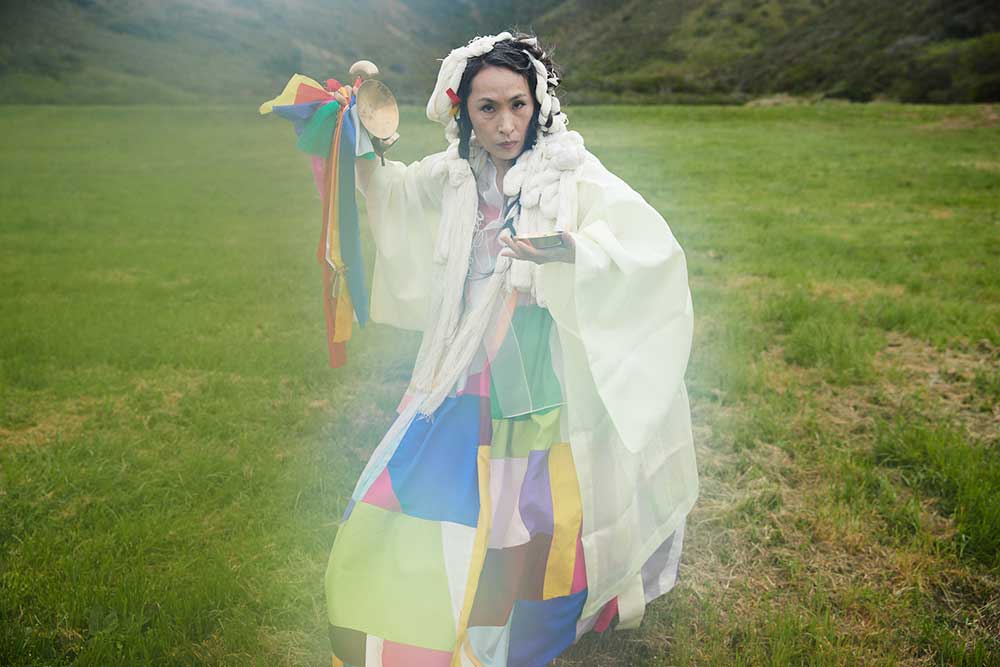
Dohee Lee. Photo by Alex Farnum for YBCA.
YBCA: What was the inspiration behind MU–Connector/When the land stands alone and how does it differ from past offering performances that you’ve done?
Dohee Lee: Yeah, the real big inspiration of this MU–Connector/When the land stands alone is really about my own ancestral land, back to JeJu Island in Korea, and what they are still confronting, in their daily lives with their land. The military base is always building out there, and that is really destroying the sacred land and people too. I see how people are suffering, not only the people, land is suffering. I saw it, and then when I see another place where I’m living, it’s the same problems that we’re dealing with, so I felt it’s really important to really raise up the land justice here. What is the right way to understand land and how we connect with it?
So I felt those are the main concerns and also inspiration to how I can create a solidarity between these people struggling for their own indigenous land, protecting their sacred land, and protecting the land in peace rather than with wars.
YBCA: What are you hoping that audiences take away with them after experiencing MU Connector/When the land stands alone?
Dohee Lee: I want people to think about their ancestral land and their ancestors and their stories and their histories. How are those connected to your own body and yourself? What are your responsibilities to live in this land? I want the audience to take those questions and then ask themselves.
YBCA: What does collective community healing look like?
Dohee Lee: The process of healing is not pretty. Honestly, it’s really hard because you have to be vulnerable, and you have to be okay with that. It takes a long time because before even being vulnerable, we have to create a space that you feel comfortable with and from there we also build trust. So this is the repetition and with time, vulnerabilities can come out. A lot of tears, a lot of anger, a lot of desperation, a lot of grief. [In that space] we can hold on to each other; we can understand each other.
So I feel like community healing just takes time. It’s not easy to do but when we do it, it’s so powerful because you see the transformation happening in each of us. So to me, that’s the beauty of communal healing and that’s the resilience of the healing. Our ancestors, they’re teaching us what resilience looks like. I have a huge appreciation for members of our community, because without them and without their vulnerability, genuineness, passion, and compassion, I could not do this.
YBCA: Why did you decide to include I Hear a Butterfly as a part of your performance run? What can audiences expect from the film screenings? Why did you decide to incorporate it into this run of shows?
Dohee Lee: I Hear a Butterfly is a collection of films that we put together under one title, but those mostly come from the Asian Refugees United, who we are partnering with for this performance. One film that you will see is their journey, where they’re from;going back to his refugee camps and showing that.
And still, in refugee camps, these people are still there waiting to go to another country that becomes their place to live. But at the same time, there are three generations living in refugee camps. Another part is how people are creating their performance, this piece, the behind it. So some of the problems are really kind of showing the process of the work or identity.
The queer trans Vietnamese community is really sharing their own identity; showing their stories of who they are. Each film has a very strong message of who they are, where they’re from, and where the ancestral land is that they want to belong to. And also, what are the works that are so important to each of us.
YBCA: You’ve been working with YBCA for a while now. Can you tell us about the first time you worked with YBCA, and how YBCA has supported you throughout the years?
Dohee Lee: In 2008 I did this project which combined the history of Korea, and how America was involved in Korea’s history. I returned in 2014 for Mago. I was supposed to come back in 2020, but now in 2023, I’m back with my third work, MU–Connector/When the land stands alone.
I feel like YBCA is becoming home. I’m coming back with the work that I can share with the people. I have that relationship that was built together, it’s a really long relationship.
YBCA really supports a lot in that way so I really appreciate that they see the value of our work that we’re doing. YBCA is the place where I feel like I can bring my art here and share it with people. YBCA is a sharing space for the community too. I’m very happy to be part of that. I see YBCA as our community’s home.
For tickets and more information on Dohee Lee’s performance of MU–Connector/When the land stands alone presented by Yerba Buena Center for the Art visit: https://ybca.org/event/dohee-lee-mu-connector/

